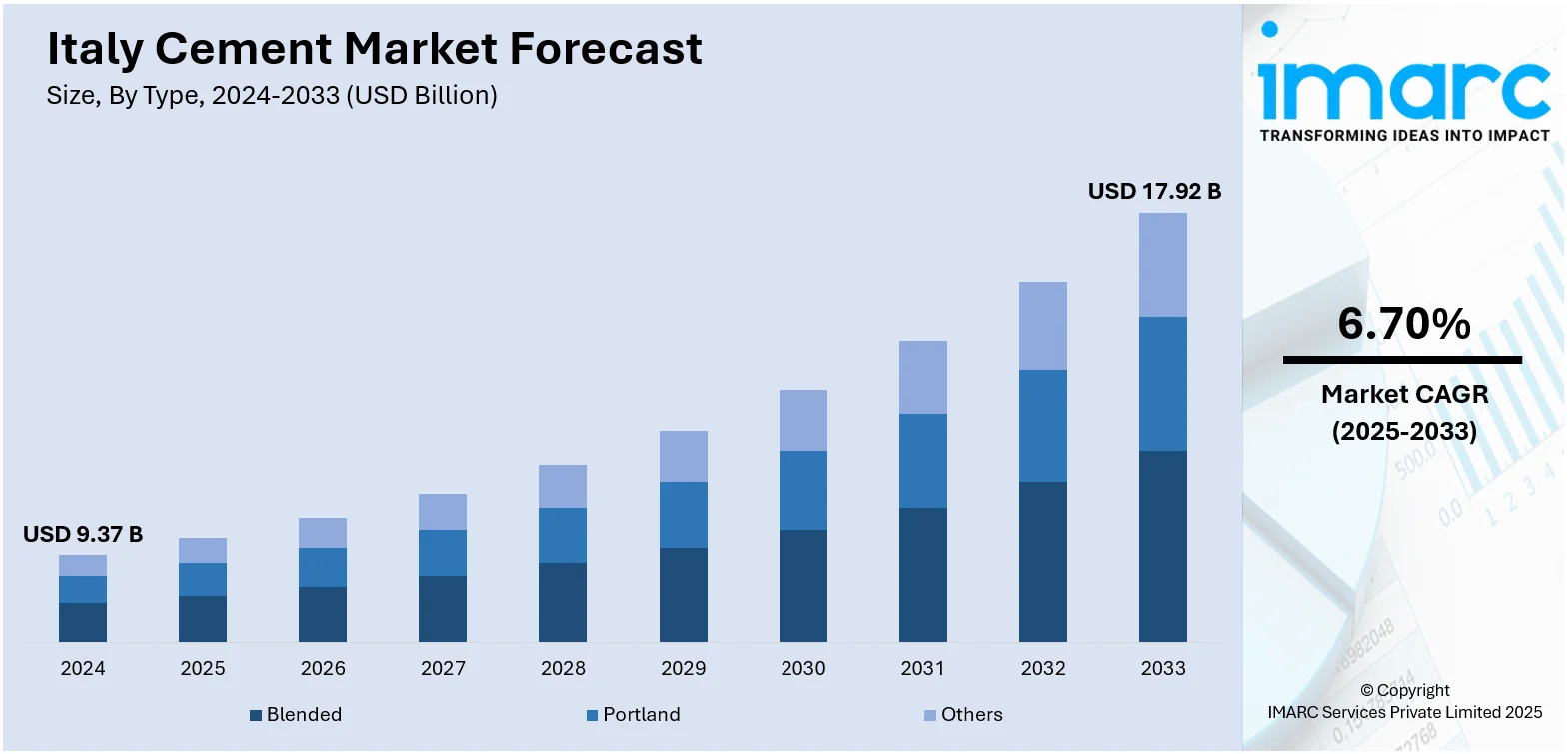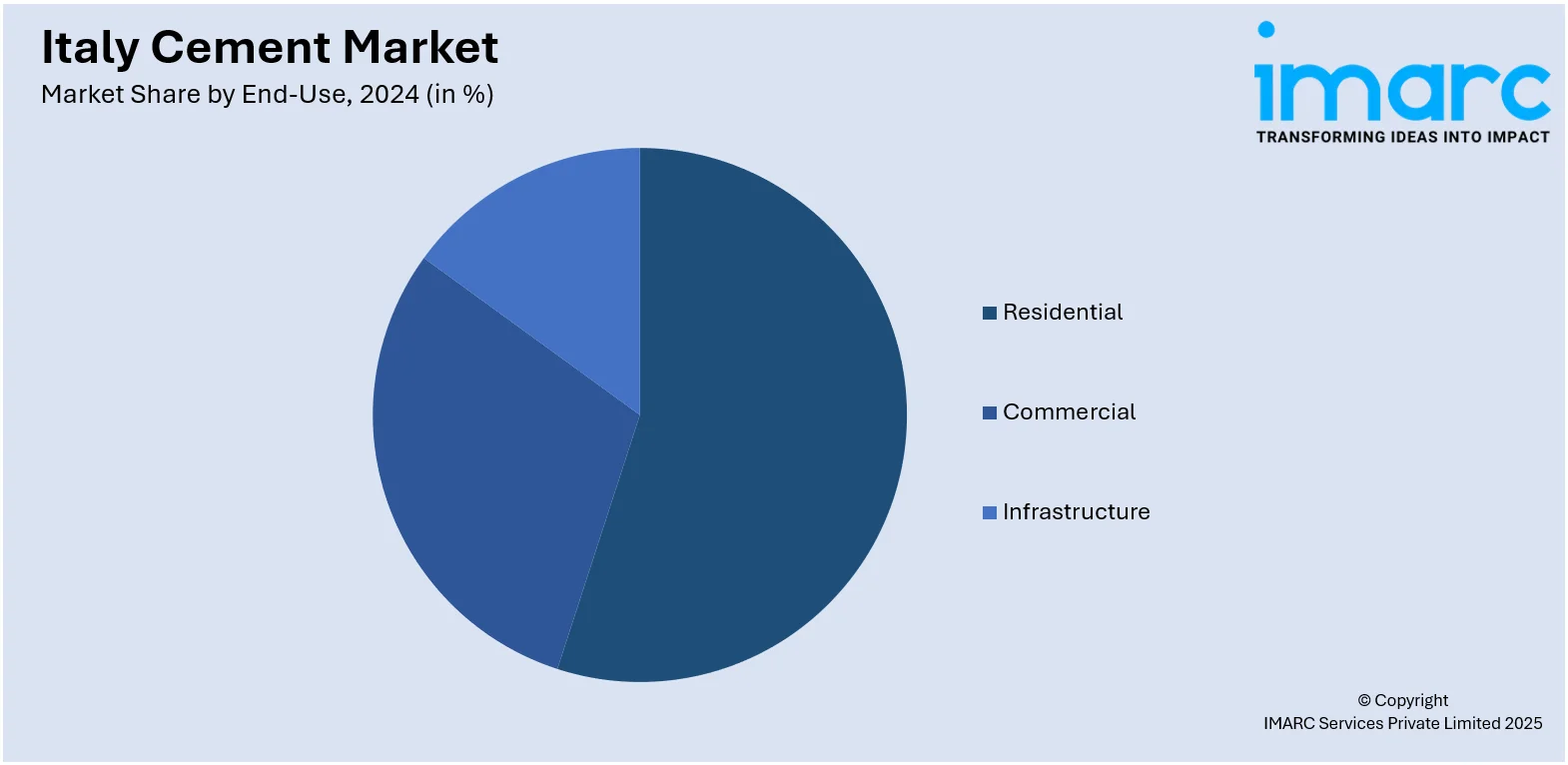
Italy Cement Market Size, Share, Trends and Forecast by Type, End-Use, and Region, 2025-2033
Italy Cement Market Overview:
The Italy cement market size reached USD 9.37 Billion in 2024. Looking forward, IMARC Group expects the market to reach USD 17.92 Billion by 2033, exhibiting a growth rate (CAGR) of 6.70% during 2025-2033. The cement market in Italy is driven by growing infrastructure projects and a focus on sustainability. Large-scale developments, government modernization efforts, and private investments boost the demand for cement. Additionally, technological advancements and eco-friendly innovations, including carbon capture and energy-efficient production, support the environmental goals and contribute to the expansion of the Italy cement market share.
|
Report Attribute
|
Key Statistics
|
|---|---|
|
Base Year
|
2024 |
|
Forecast Years
|
2025-2033
|
|
Historical Years
|
2019-2024
|
| Market Size in 2024 | USD 9.37 Billion |
| Market Forecast in 2033 | USD 17.92 Billion |
| Market Growth Rate 2025-2033 | 6.70% |
Italy Cement Market Trends:
Growing Infrastructure Projects
The demand for cement in Italy is being significantly driven by an increase in large-scale infrastructure projects, which include public works like road construction, bridges, and tunnels, as well as urban development. The focus of the governing body on modernizing and expanding the country’s infrastructure, combined with substantial private investments, is leading to a rise in cement usage. A prime example of this is the 2025 €1.6 billion tender launched by FS Group (Rete Ferroviaria Italiana) for the Santomarco Tunnel, part of the Salerno–Reggio Calabria high-speed rail project. This development includes a 22km section, with a 17km tunnel and a new station in Cosenza, aimed at improving connectivity in southern Italy. Such large-scale projects place considerable demands on cement production, especially with the push for more sustainable infrastructure. As a result, there is an increase in the need for specialized types of cement, such as eco-friendly variants, which further contributes to the market expansion. With a focus on reducing carbon emissions and increasing the lifespan of infrastructure, these projects also encourage innovation in cement products. As Italy continues to invest in modernizing its infrastructure, both public and private sector initiatives play a critical role in shaping the demand for cement, solidifying its importance in driving growth in the construction market.

To get more information on this market, Request Sample
Technological Advancements and Sustainability Efforts
The cement market in Italy is experiencing a shift toward greater technological advancements and sustainability efforts, with manufacturers increasingly prioritizing eco-friendly solutions. Companies are putting money in research operations to improve production processes, reduce carbon emissions, and develop green cement alternatives that align with global environmental goals. One notable example is the 2024 launch of a carbon capture pilot plant at Buzzi Unicem’s cement facility in Monselice, Italy, by Nuada. The pilot used energy-efficient MOF-based VPSA technology to capture one ton of CO₂ per day, contributing to the industry's push toward Net Zero 2050 targets. This project, supported by the Global Cement and Concrete Association (GCCA), highlighted the cement sector's commitment to sustainable practices while meeting the increasing demand. Besides this, the adoption of innovative technologies, such as automated production lines and waste-recycling techniques, are further boosting productivity and minimized environmental impact. As stringent climate goals continue to shape global policies, the cement industry is finding a balance between meeting construction demands and adhering to sustainability standards, positioning these advancements as key factors supporting the Italy cement market growth.
Italy Cement Market Segmentation:
IMARC Group provides an analysis of the key trends in each segment of the market, along with forecasts at the country and regional levels for 2025-2033. Our report has categorized the market based on type and end-use.
Type Insights:
- Blended
- Portland
- Others
The report has provided a detailed breakup and analysis of the market based on the type. This includes blended, Portland, and others.
End-Use Insights:

- Residential
- Commercial
- Infrastructure
A detailed breakup and analysis of the market based on the end-use have also been provided in the report. This includes residential, commercial, and infrastructure.
Regional Insights:
- Northwest
- Northeast
- Central
- South
- Others
The report has also provided a comprehensive analysis of all the major regional markets, which include Northwest, Northeast, Central, South, and others.
Competitive Landscape:
The market research report has also provided a comprehensive analysis of the competitive landscape. Competitive analysis such as market structure, key player positioning, top winning strategies, competitive dashboard, and company evaluation quadrant has been covered in the report. Also, detailed profiles of all major companies have been provided.
Italy Cement Market News:
- In February 2025, Alpacem GmbH acquired the Fanna cement plant and several concrete mixing facilities in Italy from Buzzi SpA. The Fanna plant, modernized recently, has a cement capacity of 0.9Mta.
- In September 2024, Heidelberg Materials began a feasibility study for a carbon capture project at its Rezzato Mazzano cement plant in Brescia, Italy. The initiative aimed to produce Net Zero cement by transporting captured CO₂ to the Ravenna CCS hub under the Adriatic Sea. This could make it the first plant in Italy to achieve such a milestone.
Italy Cement Market Report Coverage:
| Report Features | Details |
|---|---|
| Base Year of the Analysis | 2024 |
| Historical Period | 2019-2024 |
| Forecast Period | 2025-2033 |
| Units | Billion USD |
| Scope of the Report |
Exploration of Historical Trends and Market Outlook, Industry Catalysts and Challenges, Segment-Wise Historical and Future Market Assessment:
|
| Types Covered | Blended, Portland, Others |
| End-Uses Covered | Residential, Commercial, Infrastructure |
| Regions Covered | Northwest, Northeast, Central, South, Others |
| Customization Scope | 10% Free Customization |
| Post-Sale Analyst Support | 10-12 Weeks |
| Delivery Format | PDF and Excel through Email (We can also provide the editable version of the report in PPT/Word format on special request) |
Key Questions Answered in This Report:
- How has the Italy cement market performed so far and how will it perform in the coming years?
- What is the breakup of the Italy cement market on the basis of type?
- What is the breakup of the Italy cement market on the basis of end-use?
- What is the breakup of the Italy cement market on the basis of region?
- What are the various stages in the value chain of the Italy cement market?
- What are the key driving factors and challenges in the Italy cement market?
- What is the structure of the Italy cement market and who are the key players?
- What is the degree of competition in the Italy cement market?
Key Benefits for Stakeholders:
- IMARC’s industry report offers a comprehensive quantitative analysis of various market segments, historical and current market trends, market forecasts, and dynamics of the Italy cement market from 2019-2033.
- The research report provides the latest information on the market drivers, challenges, and opportunities in the Italy cement market.
- Porter's five forces analysis assist stakeholders in assessing the impact of new entrants, competitive rivalry, supplier power, buyer power, and the threat of substitution. It helps stakeholders to analyze the level of competition within the Italy cement industry and its attractiveness.
- Competitive landscape allows stakeholders to understand their competitive environment and provides an insight into the current positions of key players in the market.
Need more help?
- Speak to our experienced analysts for insights on the current market scenarios.
- Include additional segments and countries to customize the report as per your requirement.
- Gain an unparalleled competitive advantage in your domain by understanding how to utilize the report and positively impacting your operations and revenue.
- For further assistance, please connect with our analysts.
 Request Customization
Request Customization
 Speak to an Analyst
Speak to an Analyst
 Request Brochure
Request Brochure
 Inquire Before Buying
Inquire Before Buying




.webp)




.webp)












